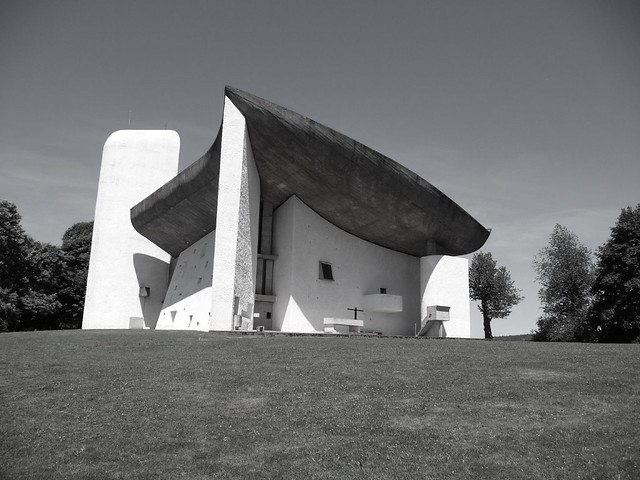Unusual, yet awe-inspiring, the Ronchamp chapel has to been seen to be believed
I must confess that I am slightly privileged by the fact that, working constantly with architects, I am occasionally offered trips to see buildings of interest, whether here in the UK or abroad. One such occasion was when our company worked with Make Architects in London, who decided to celebrate a planning permission they received in Fitzrovia with a grand trip. The proposal was to visit the city of Basle and Vitra furniture headquarters in Switzerland, make our way to the Vitra Design Museum in Germany, and then finally onto Corbusier’s Notre Dame du Haut, a chapel in Ronchamp, France. What a fantastic opportunity! My colleagues at Derwent and I wasted no time in accepting, and I knew I was in for a rather special architectural treat.
The story of the Ronchamp chapel started in 1950, when Corbusier was commissioned to design a new Catholic church to replace one that had been destroyed during the second world war.
The Church wanted a pure space, void of extravagant detail or ornate religious figures, and therefore unlike its predecessors; Corbusier wanted the space to be both meditative and reflective in purpose.
When our group first approached the building, it evoked a sense of incredulity amongst us. Despite having seen many pictures of the chapel, we were not prepared for the feeling provoked upon seeing the building first-hand for the very first time. I suppose it was the power of sublime architecture that was at hand.
Firstly, the building is comprised of such an unusual, organic shape, but it is the roof that instantly grabbed my attention. It seemed to defy the logic of geometrics, and yet it was so graceful and serene – like an oversized cloud attaching itself onto the main structure.
The Ronchamp chapel sits among a wooden terrain, secluded from the rest of the community. On arrival, we walked around the outside of the building surveying its irregular sculptural form, even viewing it from above due to its location within a hilly enclave. This enabled us to first appreciate its beauty before entering. Now I am not a particularly spiritual individual, but upon entering the chapel for the first time, I felt a euphoric wave of tranquillity envelope me. It was the quality of light as much as anything that influenced these feelings. One of the interesting aspects of Corbusier’s design is the sporadic window placement on the walls. Amplifying the light within the chapel, these small, puncturing apertures were implemented on the façade by tapering the window wells within the cavity of the walls. Consequently, each wall becomes illuminated by these varying window frames, which then give the walls these luminous qualities. Such light defines the chapel, giving it an experiential meaning.
Built in 1955, it has become one of the finest examples of Corbusier’s work, attracting as many as 80,000 visitors each year. The structure is made mostly of concrete and stone and is comparatively small. Some have described Ronchamp chapel as the first post-modern building, others, the first of Expressionist architecture after World War II.
The south wall of the Ronchamp chapel is totally individual; rather than designing a straight 50cm thick concrete piece, Corbusier spent months trying to perfect the outside wall. Consequently, he created a wall that starts as a point on the eastern end and expands up to 10 feet thick on its western side. What makes it even more extraordinary is that as it moves from east to west, it curves towards the south. In order to further expand his design’s complexity, Corbusier decided to make the windows to the wall in an original format. The openings slant towards their centres at varying degrees, thereby letting in light at various angles. The effect within the chapel is stunning. These windows, of differing sizes, are then scattered in an irregular pattern across the wall. Corbusier always insisted that the pattern created by the windows was not arbitrary but based on a proportional system built on the golden section. The glass used for the windows is sometimes clear, but often decorated with small pieces of stained glass in typical Corbusier colour; red, green and yellow. These stained elements shine like rubies and emeralds and act as the jewels to this beautifully designed wall.
As a symbolic gesture, Corbusier filled the inside of the wall with the rubble from the original chapel. Therefore, the old church and much of its history would remain within the site.
Perhaps one of my favourite elements of this unique and wonderful building is an external door that is used as a canvass for a stunning, abstract work of art. It resembles a Picasso painting, but then, of course, Corbusier was a talented artist in his own right.
Indeed, the whole structure of Ronchamp chapel is akin to an aesthetically astute and contemporary abstract sculpture. It is a truly magnificent building, both inside and out; a powerful piece of architecture that exudes genius. Ultimately, it demonstrates the power of a great architect.







